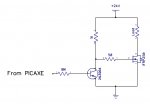plasmaninjaa
Member
Hi guys.
I am having trouble understanding how to impliment a mosfet and transistor in the way that I need, and am hoping someone could help me out with this really simple problem.
I havent taken any pictures of an actual circuit yet because this is a "How am I supposed to make this circuit" question, and not a "Here is my circuit which I know is supposed to work but is not".
Let me explain.
I have a varying voltage that is varying from 0-12v. this is being controlled by a varying 0-4v dc to tip102 darlington transistor circuit as seen in image 1 of the attachement.
This is working perfectly. I have it connected to a 12v led strip and it fades with the signal perfectly.
I have another circuit, image 2, that uses a mosfet (irfp250) to fade much bigger lights. It is being sent a varying 0-12v signal (NOT from the first circuit), and it works perfectly.
So I am trying to figure out how to get varying 0-12v from the first circuit to feed into the gate and control the second circuit. However I am not sure how to do this because the output of the darlington transistor is connected to the anode of the load, and the cathode of the load is to common +ve. Where as I think I need it the other way to control the mosfet (the anode of the load is connected to common ground and the cathode is connected to the transistor.) I have tried this arrangement (image 3) but it does not work in the same way the first circuit does in fading the 12v led strip, and I am not sure why (I think the internal diode?).
So yeah all I want to do is use my varying 0-12v circuit from image 1 to modulate the mosfet from image 2.
I am sure this is a really easy problem to solve, I just do not have as good of an understanding of transistors and mosfets as I would like.
Any guidance would be very appreciated. Thank you!
PICTURE ATTACHEMENT:
I am having trouble understanding how to impliment a mosfet and transistor in the way that I need, and am hoping someone could help me out with this really simple problem.
I havent taken any pictures of an actual circuit yet because this is a "How am I supposed to make this circuit" question, and not a "Here is my circuit which I know is supposed to work but is not".
Let me explain.
I have a varying voltage that is varying from 0-12v. this is being controlled by a varying 0-4v dc to tip102 darlington transistor circuit as seen in image 1 of the attachement.
This is working perfectly. I have it connected to a 12v led strip and it fades with the signal perfectly.
I have another circuit, image 2, that uses a mosfet (irfp250) to fade much bigger lights. It is being sent a varying 0-12v signal (NOT from the first circuit), and it works perfectly.
So I am trying to figure out how to get varying 0-12v from the first circuit to feed into the gate and control the second circuit. However I am not sure how to do this because the output of the darlington transistor is connected to the anode of the load, and the cathode of the load is to common +ve. Where as I think I need it the other way to control the mosfet (the anode of the load is connected to common ground and the cathode is connected to the transistor.) I have tried this arrangement (image 3) but it does not work in the same way the first circuit does in fading the 12v led strip, and I am not sure why (I think the internal diode?).
So yeah all I want to do is use my varying 0-12v circuit from image 1 to modulate the mosfet from image 2.
I am sure this is a really easy problem to solve, I just do not have as good of an understanding of transistors and mosfets as I would like.
Any guidance would be very appreciated. Thank you!
PICTURE ATTACHEMENT:


